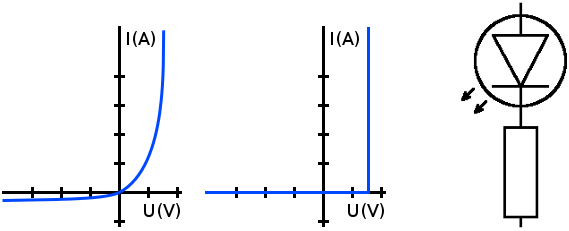
Light-emitting diodes are what we see almost in every electronic device as small color light source or indicators. Many people would still call them "lamps" which is not quite correct - though on other hand many lamps (lighting devices for rooms and streets) are now based on LEDs.
Practical LEDs for visible light evolved some half-century ago, in 1970-s, and initially their prices were quite forbidding - perhaps, dozens or even hundreds dollars per piece. Nowadays electronics hobbyist can buy a handful of them for single dollar.
But let's turn to basic physics of feeding them with electric power. In older time when, for example, the hand torches used miniature incandescent bulbs, these were directly connected to battery. All these lamps had convenient property of self-limiting the current passing through them.
If you try to attach LED directly to the battery of few volts, you generally see it giving bright light of wrong color and quickly dying out - in other words, they burn almost immediately!
To understand why, let's have a look at the images above. Leftmost chart represent what current flows through diode (and LED particularly) at
the given applied voltage. So called current-voltage characteristic (or I-V Curve). It's obviously non-linear, non-Ohmic (not behaving
in accordance to "Ohm law"). Small voltages almost do not cause any noticeable current until some threshold is reached, then current increases
dramatically.
Rough but handy practical approximation is shown in the second chart:
- There is no current (
I = 0) while the applied voltage is below threshold value - When voltage reaches threshold, any current may flow through diode, and is limited only by external circuit properties
From this follows interesting fact - that voltage drop on diode could not be above threshold value - as the current grows potentially to infinity, it causes voltage drops in other parts of the circuit. For example if we plug diode directly into battery terminals, it is battery's own internal resitance which limits the total current (and it is large enough to burn diode quickly).
Problem
Look at the rightmost image - it is the most typical task about LED. We need to plug the LED into schematic, we know supply voltage U and
estimate voltage drop on diode as Vd (the same what we called threshold voltage above - in typical working conditions it is 1.5 volts for
red diodes, 1.8 for green, 3 volts for white, for example). And we have some idea about which current Id we want to flow through the
diode (it directly affects its brightness) - typically it is something in range 1 .. 20 milliamperes.
We want to know what resistance should be added in series with diode, so the current is limited to the wanted value.
While it is almost "mental" calculation, it nevertheless employs in simplest form three important laws of electric chains:
1-st Kirchhoff's Lawmeans that the current through diode is the same as through resistor (as there is no path for any part of current to wander anywhere astray).2-nd Kirchhoff's Lawsays that supply voltage equals to sum of voltage drop on components.Ohm's Law, to which resistor (unlike diode) obeys, will help to calculate current through resistor, when you know voltage on it.
So you are given U, Vd and I and are required to create a formula which returns R - resistance we need. (in practice resistors
are not manufactured for any arbitrary value, but we generally are able to pick something close among standard nominals)
Example with numbers:
U = 4.5 V
Vd = 1.5 V
I = 3 mA
This should result in resiston R = 1 kOhm. Note that we are given current in milli-Amperes (1/1000 A) and want resistance in kilo-Ohms
(1000 Ohm) - these are most typical units in electronics.